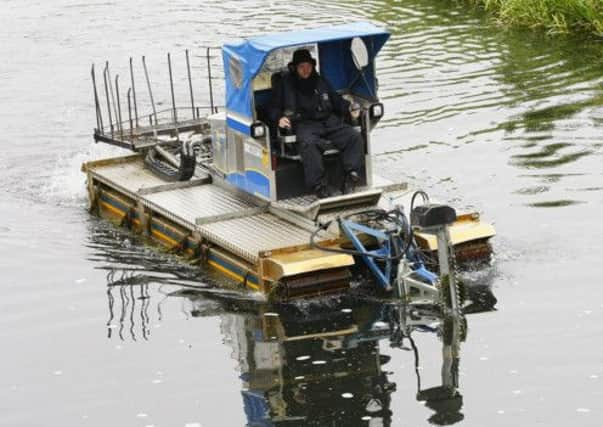Plan to recycle silt taken from Scotland’s canals


Scottish Canals is working with Strathclyde University on the potential money-spinner, which it hopes will make dredging self-financing. The two-year project could be expanded to include propeller-fouling aquatic plants, which also have to be removed from the waterways.
The UK-first initiative comes as the organisation expects to have to double its dredging following the first hydrographic survey of canal depths for five years. The company spends £250,000 a year removing up to 4,000 tonnes of material, using diggers on barges.
Advertisement
Hide AdAdvertisement
Hide AdHowever, this is focused on specific trouble spots where silt has built up and the survey is expected to show the need for far more widespread dredging, which would increase the amount removed to 8,000 tonnes. Sediment builds up from rotting leaves and vegetation, some of which comes from burns feeding into the canals.
Scottish Canals currently pays to dump it in landfill sites, after treatment to remove any toxic substances.
David Lamont, Scottish Canals’ director of change and innovation, said the plans were sure to be popular with many of the 22 million annual canal users if they meant obstacles in the water would be cleared quicker. He said: “We have narrow boats, cruisers and canoeists, so the challenge is to make sure the channel is deep enough.”
Lamont said the project was exploring how the soil could be dried out and compacted to make building blocks. Other possible uses include soil being sold in garden centres as an alternative to peat, or as an ingredient in concrete production.
He added: “It is hoped that through this project, Scottish Canals could become ‘cost-neutral’ as far as dredging activity is concerned.
“If we can generate money, this is a bonus, and is particularly relevant given that we expect the amount of dredging we do to increase.”
Lamont said the project could be extended to include weeds, which are currently cut using a special machine. Around 3,000 yachts and other vessels a year use the canals to travel across Scotland, with a further 500 boats permanently moored on the four waterways.
They can be damaged by hitting the bottom or becoming caught up in weeds, with incidents costing up to £5,000 each.
Advertisement
Hide AdAdvertisement
Hide AdThe Union canal, between Falkirk and Edinburgh, should be 3ft 6in deep, and the Forth & Clyde, between Bowling and Grangemouth 6ft.
The Highland canals are deeper because they were built for larger vessels. The Crinan, between Crinan and Ardrishaig, should be 9ft 6in and the Caledonian, between Fort William and Inverness, 13ft 6in.
Boat operators were delighted at the prospect of a clearer run along the canals.
Pat Bowie, manager of Re-Union Canal Boats in Edinburgh, said: “This part of the canal could do with being dredged because it does not seem to have been for a long time. If you are in the middle of the canal it is just about OK, but some people struggle when boats pass and they have to move to the side.”
Dr Richard Lord, director of knowledge exchange for the department of civil and environmental engineering at Strathclyde University, said: “We are delighted to help Scottish Canals develop viable uses for sediment and plant matter removed from the canal network. Dredging of the canal network will benefit recreational users and tourism, and has the potential to stimulate regeneration and provide low-carbon transport options.”
Environmental groups said the move would make canals even greener.
WWF Scotland director Lang Banks said: “Scotland’s canals are already good for wildlife, and provide a low-impact way to travel or move goods around the country.
“If this initiative is successful then it would further enhance the good environmental credentials of canals.
Advertisement
Hide AdAdvertisement
Hide Ad“Finding ways to avoid dumping dredging wastes in landfills should be good for the environment as well as the bottom line. Other places have shown that, if treated correctly, what was once considered an expensive waste could be put to a practical use.
“If Scotland is to transform how it uses resources and become a zero-waste society then every business and large organisation will need to find ways to avoid creating waste and find better ways to deal with any waste that is generated.”
Twitter: @AlastairDalton